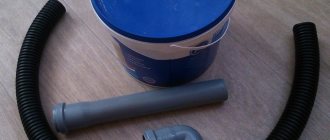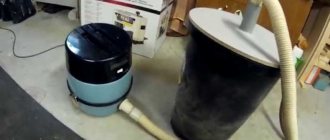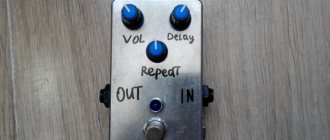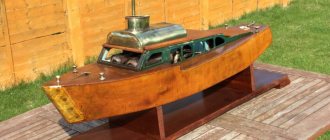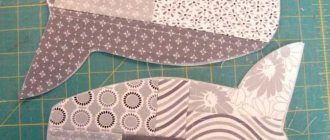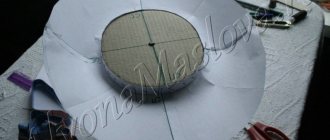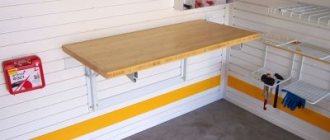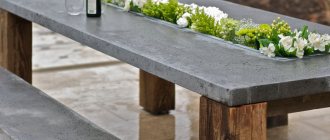One of the useful electrical appliances that many houses and apartments have is a vacuum cleaner. To clean efficiently, experts advise choosing a model with an aqua filter.
This vacuum cleaner perfectly removes dirt and also absorbs dust from the air. You can build a water filter for a vacuum cleaner with your own hands; for this, ordinary devices are used, for example, plastic bottles, pots or buckets.
Disadvantages and advantages of vacuum cleaners with a water filter
The stores have a huge selection of vacuum cleaners equipped with a water filtration system. They differ from each other in configuration and various functions, and they all have their own advantages and disadvantages.
Here is a list of the main advantages of these electrical appliances:
- high-quality cleaning. The vacuum cleaner removes the smallest particles of dust, dirt, pet hair and other debris;
- allow you not only to clean carpets and upholstered furniture, but also make it possible to thoroughly wash floors and also collect liquid from the floor;
- Excellent replacement for an air purifier. Thanks to this vacuum cleaner, the air is filtered efficiently, dust and other allergens are removed from it.
- impressive size and considerable weight. Carrying such a device or carrying it across thresholds from one room to another is quite difficult.
- Upon completion of use, the internal parts and reservoirs must be washed and dried. If this is not done, then during subsequent use a not very pleasant smell will appear;
- It is important to strictly follow the operating instructions. If you violate the manufacturer’s recommendations, unpleasant odors will appear and water will begin to pour out;
- considerable cost. Devices with an aquafilter are not cheap, but their price gradually pays off, since you do not need to purchase a replacement bag or filter.
Disadvantages of an electrical appliance with an aqua filter:
Such a device is not very complicated in design; it will be useful for those who have animals at home, as well as if a person has any diseases of the respiratory tract or organs. This useful device allows those with asthma and allergies to breathe more freely.
How to make a water filter yourself
In every home there is an unnecessary bucket, pieces of pipes or hoses.
If you are a fan of experiments and are willing to put in a little effort, then you can make a simple and cheap modification to a simple vacuum cleaner. We offer easy-to-execute work options. They do not include the manufacture of a separate filter. This modification, when done independently, is more complex and will require additional elements and skills in handling equipment. In addition to the filter container and fasteners, you need to find a separator, pump and fan that match each other in height and size.
Let's turn to more affordable ways to make a filter with your own hands.
From a bucket or pan
Materials and tools
To work, you need to prepare a container of 7–10 liters
. This could be a plastic bucket (for example, one used for paint or putty) or a saucepan. A tight-fitting lid is a must.
In addition, you will need 2 pieces of plastic pipe, fabric, clamps for fastening, drill, glue
Operating procedure
- In the bottom you need to drill a hole
to the diameter of the plastic pipe. - We insert a piece of plastic pipe into the hole
, onto which we will then attach the vacuum cleaner hose.
To fix
on the outside, coat them with glue
,- From the inside of the lid, cover the pipe with a piece of fabric and secure it with a clamp
. The fabric will serve as an additional barrier, which will reduce the number of dust particles that get into the vacuum cleaner bag. - In the side of the bucket we cut a round hole
for the second piece of pipe. - We insert it into the container at an angle downwards and fix it with glue. We will attach a hose from a vacuum cleaner with a cleaning attachment to it.
The air coming out of this pipe into the bucket will hit its wall, swirling the trash and creating centrifugal force. The garbage will not be sucked into the vacuum cleaner, but will settle in water that has been previously poured into the container of a homemade aquafilter. Pour a little liquid
. It should not reach the pipe.
Materials and tools
To make it you will need an aluminum pan, a 5-liter plastic bottle that will fit in the pan, a flexible hose and screws
Operating procedure
- To make the construction easier, cut out the bottom of the pan
. - Using self-tapping screws, we fasten the container with the vacuum cleaner at the point where the air exits.
- We drill several holes in the bottle, pour about a liter of water and insert it into the pan.
- We attach one end of the hose to the adapter on the vacuum cleaner, and lower the other into the bottle.
Before you start cleaning, fill the bucket with water, connect all the hoses and close the lid tightly. After the procedure, you need to remove the lid from the bucket, pour out its contents, clean and dry the container.
Proceed with the implementation of a water filter manufacturing plan only after a thorough analysis of all available information and a real assessment of your capabilities.
In this case, the modernization process will be successful, and you will become the owner of a modern apartment cleaning apparatus. After modification, your vacuum cleaner will be able to clean not only various surfaces in the room, but will also freshen the air in it.
Probably every housewife will agree that the house cannot do without such an important thing as a vacuum cleaner. Among the great variety of models, experts advise in order to get better cleaning results
With such models, dust absorption occurs more efficiently. They have recently become increasingly popular. If your model does not have a device that contains water, which allows for better cleaning, then do not be upset.
How does a water filter work?
Even if you recently purchased a vacuum cleaner without a water filter or you have a slightly outdated model at your disposal, don’t worry, below we’ll look at how you can make a water filter for your vacuum cleaner model with your own hands.
Making an aqua filter from a pan and a plastic bottle, detailed instructions
You will need a pan, for example, made of aluminum, and a bottle with a capacity of five to six liters so that it fits in the pan. You will also need a hose and several screws.
Proceed according to the following scheme:
Water is poured into the pan, all the tubes are connected, and the lid is sealed. When the use of the vacuum cleaner is completed, the lid is removed, the dirty water is poured out, the container is cleaned and dried.
Even more useful tips are in the video:
Let's look at two simple ways to make this type of filter
Option 1
To work you will need:
— an oil filter to retain fine dust (sold in automobile stores), — a 20-liter bucket with a well-closing lid, — one polypropylene elbow with angles of 45 and 90 degrees, — a meter-long plumbing pipe, — a two-meter corrugated pipe.
Operating procedure:
- Make a hole in the center of the bucket lid at a 90 degree angle. Here you need to connect the vacuum cleaner in the future.
- Fill the cracks with sealant.
- Make a hole on the side of the bucket and install a corner.
- The corrugation and the elbow will be connected by a pipe.
- To make the filter last longer, put nylon tights on it.
- Connect the elbow in the bucket lid and the filter outlet.
If the filter cannot be placed on the outlet pipe, you can use a rubber hose. It is recommended to use sealant to seal all connections.
Instead of a bucket, you can use a plastic barrel or tin container.
Option 2
To make this you need a traffic cone.
VIDEO
To work you need:
- traffic cone (sold in automotive stores),
- two rods 2 meters long and 8 mm in diameter,
- nuts and washers 8 mm,
- two corrugated two-meter tubes.
Operating procedure:
- Cut off the base of the cone and insert it upside down into the bucket.
- Insert the tube into the bucket. Fill the space between the tube and the cone with construction foam.
- Cut a square from a sheet of plywood 20 mm thick. It should be of such a size that the base of the cone fits on it, and there is a small margin left.
- Make holes with a diameter of 8 mm in the corners of the plywood square. Another hole is needed in the center for a tube on which a corrugated hose will be placed to secure the filter and the vacuum cleaner.
- Use a sheet of durable multi-layer plywood as a lid for the bucket. It should be firmly attached to the bucket. The edges of the sheet are covered with a layer of rubber.
- Make a hole in the lid to install the narrow end of the cone.
- The cone installed in the lid is fixed with foam and four rods.
- In the wide part of the base of the cone, make a hole for a tube that will connect to a corrugated hose. Debris from outside will subsequently flow through this hose.
This do-it-yourself cyclone model does not provide a fine filter, so small debris will penetrate into the turbine.
Types of aquafilters
There are two types of water filters:
Separate.
The work of this type of aqua filter is to separate air from dust particles due to centrifugal force. Contaminated particles that enter the filter remain in the water without entering the air of the living room. The main advantage of vacuum cleaners of this type is the higher quality of cleaning compared to others, and they are also durable. However, separate models are not cheap.
Separate filter
Hookah bars.
Vacuum cleaners of this type have a fairly simple design. These devices cope better with coarse dust, but they have a hard time with fine dust. However, this drawback can easily be corrected by installing additional filters. One of the inconveniences of using a hookah filter is the need for frequent, systematic washing and high-quality drying. In addition, it is equipped with a fairly small liquid reservoir.
Aquafilter in a vacuum cleaner
Upgrade options
There are no boundaries for perfection. Upgrading a robot vacuum cleaner can affect both mechanics (wheels, installation of additional rotating brushes) and electronics (replacement of the Arduino board, sensors, charge controller, etc.).
It is possible that during operation the owner of the vacuum cleaner will want to paint the body; aerosol nitro enamels are suitable for this. Or replace the software, adapting it to the Android environment, so that the vacuum cleaner becomes even smarter. And it could be controlled using a smartphone. There are already ready-made ideas and solutions. Or you can come up with something of your own; the Arduino platform was created for this.
How to make a filter for a vacuum cleaner at home, description of the process
Before you make filters for a vacuum cleaner with your own hands, you need to understand on what principle these units work. And since four varieties were designated, each has its own operating scheme.
- A filter fabric bag that works by direct action. That is, air with dust gets inside the bag. Dust settles inside, clean air passes through the fabric.
- Cyclone. The air flow moves in a spiral. Heavy particles settle, air with the smallest particles rises and passes through additional filters.
- Water. Dust is captured by water.
- HEPA filter. This is a cyclonic version, in the upper part of which a filter element is installed that cleans the air from small particles.
Dust bag
It can be made from thick fabric folded in two or three layers. Simply sew a bag with a neck, the size of which should match the diameter of the pipe from the corrugated hose.
A square is cut out of thick cardboard, in which a hole is made for the pipe. This is the basis for attaching the bag. The latter can be attached to the square in several ways, for example:
- using glue;
- using Velcro.
Cyclone option
Several designs are offered here. The simplest one is a plastic paint bucket. It has a slightly cone-shaped shape, which is sufficient to provide containment for large particles.
To do this, a hole is made in the middle of the bucket lid for the vacuum cleaner pipe. In the bucket itself, on the side closer to the neck, exactly the same hole is made. Pieces of plastic pipes with a diameter of 32 mm are inserted into them.
Attention! The joints of the pipes in the holes must be sealed using silicone sealant. What else you need to pay attention to:
What else you need to pay attention to:
- the pipe inserted into the bucket should be located at an angle to the bottom of the container;
- The hole in the pipe inserted into the lid must be closed with filter material.
If you pour a little water inside the bucket, the cleaning efficiency will be much higher.
The connection diagram of the filter to the vacuum cleaner is as follows:
- a vacuum cleaner is connected to the lid pipe;
- a pipe with a nozzle to the bucket pipe.
A more serious design of a cyclone dust collector is the same bucket, to which a cone is connected to the lid. The latter can be made of thin plastic. There are many cone-type products on the market that are well suited for this purpose.
There is no need to make a hole in the bucket itself. It will serve as a dust collector. A hole is made in the lid into which the narrow part of the cone is inserted. A hole is made for the pipe on the side of the cone, closer to the upper neck. It will connect to the pipe and nozzle. A hole is made in the middle of the cone cover for a pipe that will be connected to the vacuum cleaner.
Water option
There are also several designs here. One effective option is a saucepan with a five-liter plastic bottle in it. The photo below shows this design.
Instead of a pan, you can use any product that functions as a stand for a plastic bottle. A hole is made in the latter through which the filter is connected to the exhaust port of the vacuum cleaner. The connection is made with a plastic pipe.
Several small holes are made in the top of the bottle through which purified and moist air will come out. The container is filled halfway with water.
Attention! The purpose of the filter is to clean the air coming out of the vacuum cleaner
HEPA filter
This type itself is very expensive. You can do it yourself if you use a car filter from an air conditioner located in the car instead of a filtration element. Both elements do not fit in size, so the car will have to be trimmed.
In a vacuum cleaner, the filter material is removed using a knife. The joints are cleaned of old glue and degreased. A car element is inserted and glued to the frame using any adhesive. https://sex-tumen.prostitutki72.com/shatenki
Types of aquafilters
There are two types of water filters:
Separate.
The work of this type of aqua filter is to separate air from dust particles due to centrifugal force. Contaminated particles that enter the filter remain in the water without entering the air of the living room. The main advantage of vacuum cleaners of this type is the higher quality of cleaning compared to others, and they are also durable. However, separate models are not cheap.
Separate filter
Hookah bars.
Vacuum cleaners of this type have a fairly simple design. These devices cope better with coarse dust, but they have a hard time with fine dust. However, this drawback can easily be corrected by installing additional filters. One of the inconveniences of using a hookah filter is the need for frequent, systematic washing and high-quality drying. In addition, it is equipped with a fairly small liquid reservoir.
Aquafilter in a vacuum cleaner
LGV-C9551 WNT
Korean technology is an option for those who want to get a high-quality and functional item without overpaying for the brand.
The LGV-C9551 WNT washing vacuum cleaner does not pretend to receive high-profile titles and awards; it is a reliable assistant that is always easy and comfortable to work with.
When developing this model, LG engineers put ease of service at the forefront. All containers are easily removed and washed; the user spends literally a matter of seconds on everything.
Some complaints are caused by the small volume of the reservoir for clean water and detergent; they have to be refilled quite often during operation.
Consumes 1500 W of electricity, 310 of which is spent directly on sucking up dust and dirt. The purchase will require from 8,500 to 11,000 rubles.
Types of aqua filters
Although all vacuum cleaners with water filtration work on approximately the same principle, manufacturers produce three different types of water filters.
| Hookah bars | They have the simplest design features. The sucked dirty air is passed through the water, as a result, not all small particles remain, but all large debris is absorbed. An additional filter can be installed to remove the finest dust. Hookah water filters must be periodically washed and thoroughly dried. Such filters do not have a very large capacity size |
| Cyclonic | The poured water in this filter retains dust due to the turbulence formed. Cyclonic aquafilters use centrifugal force to trap debris, dirt and dust, as a result, all contaminants become wet and cannot return to the room along with the air. The cyclone type of filter does not allow the smallest particles of dust to be retained, which do not have time to get wet in the container, so they are released back into the room |
| Separator | These devices provide the highest quality cleaning, however, these models are the most expensive. After entering such an aquafilter, dust particles are separated from the air through powerful centrifugal action. Even the smallest particles remain, and the cleanest and freshest air is sent into the room |
The principle of operation of a homemade vacuum cleaner with an aqua filter
Under natural conditions, even the smallest particles of dust are bound by water - rain, snow, dew, fog. The same principle is used in vacuum cleaners with an aquafilter: the water vortex created inside the aquafilter collects even fine dust, which no solid filter element is capable of catching.
Modern models of vacuum cleaners with a water filter not only retain up to 99.9% of sucked dust and dirt, but also purify the air and work as humidifiers.
Such devices are very convenient and economical to use - there is no need to regularly buy expensive bags and other consumables, since all the dust settles in a water tank.
To clean it, just drain the dirty water and rinse the container. The only significant drawback of vacuum cleaners of this type is the high price.
If the appearance of the device is not important, you can assemble a homemade water vacuum cleaner, which in terms of performance and efficiency will not be inferior to expensive models from well-known brands.
Such a vacuum cleaner will become an indispensable assistant not only when cleaning an apartment, but also when performing dusty construction and finishing work - scraping walls, sanding, etc.
An aquafilter is an additional working element, or rather a container of water through which the air sucked in by the vacuum cleaner passes due to vacuum.
The water filter is installed before the vacuum cleaner, as a result, all dirt and dust remain in the water, and already purified air enters the vacuum cleaner itself.
What you need to make a water filter for a vacuum cleaner with your own hands
To make a water filter for a vacuum cleaner with your own hands, you will need the following materials and tools:
- Any container with an airtight lid. This could be a 19-liter plastic cooler bottle or a large plastic bucket with a tight-fitting lid;
- Coarse foam rubber, mesh or any other reusable filter material to prevent water from entering the vacuum cleaner engine;
- Additional corrugated hose for a vacuum cleaner (will connect the vacuum cleaner and the water filter);
- Construction sealant;
- Sewer pipe with a diameter of 50 mm;
- Drill and drill bit with a diameter of 6 mm;
- Measuring tools - ruler, tape measure, pencil.
As for the pipes, their configuration and quantity are determined based on the shape and size of the container of the homemade aqua filter.
So, to make a water filter from a 12-liter plastic bucket you will need the following items of PVC pipes:
- sewer pipe d 50 mm L 250 mm polypropylene - 3 pcs.;
- tee d 50 mm L 153 mm 90 degrees - 2 pcs.;
- plugs d 50 mm - 2 pcs.
Manufacturing process - step-by-step instructions
The process of making an aqua filter itself consists of several stages:
- In the upper part of the bucket (it is enough to step back about 10 centimeters from the upper border), you need to make two holes with a diameter of 50 mm opposite each other - this will be the entrance and exit of a homemade aqua filter;
- Several holes should be drilled in the bottom of one of the tees. This should be done evenly over the entire surface. The total area of the holes should be approximately equal to the diameter of the pipe used. We put plugs on the pipe from two side ends:
- We make a hole with a diameter of 40-50 mm in one of the pipes;
- Next, we assemble the pipes into a single structure in accordance with the figure:
- Pour water into the container so that the lower part of the tee with the holes is completely covered with water;
- Close the water filter cover and connect the vacuum cleaner:
- We test the aquafilter.
VIDEO INSTRUCTIONS » alt=»»> It is recommended to carry out the first tests at low speed, monitoring the condition of the corrugated hose running from the water filter to the vacuum cleaner (it must be dry).
If traces of water are visible in the corrugated hose, it is necessary to close the air intake hole inside the filter with coarse foam rubber or other porous filter material.
Extractor for interior dry cleaning
All equipment used for dry cleaning of car interiors is divided into three categories:
- Powder pumps: with a power of up to 7 kW, these are professional equipment and consume much more electricity than vacuum cleaners.
- Extractors - pulling vacuum cleaner.
- Vacuum cleaners - usually used for cleaning household surfaces, have the lowest power.
A vacuum cleaner differs from a simple washing vacuum cleaner in that the cleaning solution is fed into it through a pump under pressure at high speed.
Containers with a cleaning solution and for receiving dirty water from a vacuum cleaner have a larger volume than a vacuum cleaner. In addition, the vacuum cleaner’s ability to vacuum liquid dirt, water and foam with dust particles and debris is very high (power more than 7 kW), which reduces the drying time of surfaces.
Based on tank volume, extractors are divided into three types:
- 20-40 l - units used by cleaning companies;
- 40 - 80 liters - equipment used for daily cleaning and very large cleaning volumes has a very powerful motor (or two).
- 7-15 l - household vacuum cleaner;
Also available with one or two motors and different power outputs (usually from 1.5 to 12 kW and fluid pressure 6-11 bar).
Important Despite the high suction power, the vacuum cleaner cannot remove all the water from fabrics and soft surfaces. Moisture is removed by only 70-80%. Therefore, after use, the machine must be actively ventilated naturally or dried with a special hairdryer.
What can a filter for a vacuum cleaner be made from?
When creating filters, various materials are used that are easy to purchase at any hardware store. A common option is foam rubber. But you can also use any dense non-woven fabric
The main thing you should pay attention to is the density of the composition. The material should pass water easily enough and at the same time retain the smallest dust
Foam filter
If the filtration element becomes dirty, you can replace it yourself in order to avoid spending money on buying a new one. To do this, you will need a piece of new foam rubber of the required thickness, or you can also use a dishwashing sponge. At the same time, if you buy material, you can buy foam rubber of different densities (the layer with a higher density will go first to the filter inlet). Using scissors, the desired size is cut out and the thickness is adjusted with the same scissors, after which the new filter is installed in the vacuum cleaner.
Filter made from other materials
The process of creating an air filter yourself involves the use of other materials. Foam rubber can be replaced with fabrics of the same density.
| Foam rubber | 25-40 kg/m³ |
| Ready-made gauze dressings | 30-32.0 kg/m³ |
| Thin denim (jeans) | 25-30 kg/m³ |
| Fabric for filters used in cars | 38-46 kg/m³ |
| Multilayer padding polyester | 30-40 kg/m³ |
| Household non-woven fabric napkin | 35-40 kg/m³ |
The manufacturing principle is the same as in the case of using foam rubber: using scissors or a stationery knife, a filter of the required size is cut out of the material.
How to make a detergent?
Using the instructions, you can make a washing device from a simple vacuum cleaner. Usually people use a washing machine very rarely. This device is intended for general cleaning of the house or when you need to wash away dirty spots.
The step-by-step instructions for creating the device are as follows.
- Where there is air flow, you need to fix the water filter. The following materials are needed for the filter: a container, an angle, a short pipe for sewage, a corrugation with a diameter suitable for the pipe. A hose from an old vacuum cleaner is suitable as a corrugation. Since the hose is very soft, it will roll up well.
- It is necessary to measure the diameter of the place where you need to insert the nozzle and extension tubes, and purchase an angle that can fit this diameter. Then you need to saw off the tube so that it cannot reach the bottom.
- Using a knife, you need to cut round holes on the lid. The diameter of the holes must be even and suitable for the tube.
- Then tubes should be inserted around the perimeter and reinforced with a glue gun.
- After this, you need to make a fabric filter for a short tube. Such a filter will prevent water drops from entering the vacuum cleaner, since the fabric is a reliable material. Using Chinese electrical tape, you need to wrap this fabric around plastic and pull it tightly.
- Next, take the hose from the vacuum cleaner and insert it into the short tube, and then attach the nozzle to it. Using electrical tape, these connections must be sealed.
- Then you need to tightly close the lid of the bucket and clean the house. As a result of cleaning, all the water will be located in the tank. And the filter will remain dry, there will only be dirt from cleaning on it. The pipe that was inserted into the vacuum cleaner will also be dry.
How to choose material for manufacturing
Motor for an electric pump The simplest model is assembled from a 2 liter bottle or a 5–10 liter container.
A hose is installed on the neck to suck up debris. A filter is mounted inside the housing. A motor from a children's toy or tape recorder is attached to the bottom of the device. The fan blades are cut out of tin, the edges are cleaned, and the impeller is mounted on the shaft from the motor. This vacuum cleaner can operate both from mains power and batteries. However, the power of the model is low and is only suitable for small ponds.
If there is no ready-made filter, it is replaced with a homemade design. For example, they sew a garbage bag from water-permeable fabric, like tulle and organza, and insert it into the receiving pipe. Then install a filter from a plumbing adapter and sponges. The edge of the adapter is sawed off at an angle and sanded, then sponges are glued to the edges. A gap is left between them for water to enter. It is better to protect foam rubber with a piece of linoleum. This design does not allow large debris, insects, leaves to pass through, and small debris is retained in the bag itself.
Vacuum cleaner from a submersible pump
Vacuum cleaner from a submersible pump for a large pool This option is much more convenient to use when cleaning the bottom of a complex configuration. A submersible pump is used for it, capable of operating under water. The step-by-step instructions are simple.
- A tee is assembled from a polypropylene pipe. The pipes are connected by soldering.
- Plugs are put on the ends of the segments.
- A longitudinal hole is cut out from the bottom of the pipe and the edges are cleaned. A handle is welded to the top of the tee.
- In the center of the plunger, extend the through hole and insert a tube into it. Connect the plunger to the corrugated pipe.
- The structure is connected to the inlet valve on the pump.
The debris in such a vacuum cleaner remains on the filter, so the latter needs to be cleaned more often.
Diagnostics of breakdowns
A malfunction of the nozzle, hose, or filter can be easily determined by visual signs. The more difficult problem is with the electrical part. The cause of poor vacuum cleaner performance is a faulty motor. However, the motor may not work well due to a defect in the cable, the power button, or a burnt-out part on the electronic board.
The following signs indicate the onset of malfunction:
- After turning on the unit, an increased hum appeared. The vacuum cleaner may work, but the first bell already signals an imminent motor breakdown.
- Weak suction power is observed when the hose is leaky, the filter is clogged with dust, or the working nozzle is damaged. If defects in these elements are not identified, the problem lies in the motor or electronic board.
- If the engine speed fluctuates or is not regulated by the wheel, the electronic unit is faulty, the brushes are worn out, or the motor armature commutator is dirty.
- A strong rumble, whistle or jamming of the engine indicates bearing failure. If it comes to jamming, there is a possibility that the stator or armature windings will burn out.
- The vacuum cleaner may not turn on the first time if the start button is broken. When the vacuum cleaner goes silent during cleaning and starts working again, the power cord is damaged. The fault often lies inside the plug, as well as in areas where the cable bends frequently.
If any breakdown occurs, the household appliance should be disassembled and repaired.
How to make a filter for a vacuum cleaner with your own hands
Fabric bag
It can be made from thick fabric if folded in several layers. You just need to sew a bag with a neck. The neck must be made of such a size that it coincides with the diameter of the pipe from the corrugated hose.
You will also need thick cardboard, from which you need to make a hole for the pipe. This will be the basis for attaching the bag. You can attach it to the square using glue or Velcro.
How to make a cyclone filter for a vacuum cleaner
In this case, you can offer several designs, the simplest of which is a plastic paint bucket. It is shaped slightly into a cone and is just enough to contain larger particles.
To do this, you need to make a hole in the lid of the bucket (in its center) for the vacuum cleaner pipe. In the bucket itself you need to make exactly the same hole, on the side, closer to the neck. You need to insert pieces of plastic pipes with a diameter of 32 mm into them.
REFERENCE! The joints of the pipes must be sealed in the holes using silicone sealant.
A more serious design of such a filter would be a slightly different version of a bucket with a cone connected to the lid. You can make a cone from thin plastic. In the store you can find a large number of cone-shaped parts that can be used for this purpose.
In this case, there is no need to make a hole in the bucket itself. It will be needed as a dust collector. You need to make a hole in the lid and insert the narrow part of the cone into it. Another hole needs to be made in the upper part of the cone, closer to the neck. A pipe connected to a pipe and a nozzle will be inserted there. To make it more clear, you can find a video on the Internet on how to do this.
DIY water filter for a vacuum cleaner
In this case, there may also be several designs. One option is a saucepan with a five-liter bottle installed in it. Instead of a saucepan, any container that can serve as a stand for a bottle will do. It is necessary to make a hole in the plastic bottle through which the filter will be connected through a plastic pipe to the exhaust port of the vacuum cleaner.
It is necessary to make several holes in the top of the bottle through which purified and moist air will escape. The bottle must be filled halfway with water.
REFERENCE! The purpose of a water filter is to purify the air that comes out of the vacuum cleaner.
Do-it-yourself Hepa filter for a vacuum cleaner
This type of filter is very expensive. You can do it yourself only using a car air conditioning filter. However, they do not fit in size, so you will need to trim the car one.
The filter material of the vacuum cleaner must be removed with a knife, then the joint area must be cleaned of old glue and degreased. Next, you need to insert the car filter and glue it to the frame using any glue.
Required materials and tools
Possible difficulties
Problems usually arise related to sealing joints. Dusty air leaks out through them
Therefore, all seams must be given special attention and sealant used.
Making a filter for a vacuum cleaner yourself is not a problem if you know the principle of operation of the vacuum cleaner and how it cleans the air from dust. A homemade filter can replace a failed filter or supplement an existing one.
Advantages and disadvantages
Before you make a filter for a vacuum cleaner with your own hands, you need to familiarize yourself with the advantages and disadvantages of a homemade container. What are the features of homemade products? The main advantage of making filters for a vacuum cleaner with your own hands is saving money that would have to be spent on purchasing factory cleaning elements.
Despite the many advantages, homemade cleaning elements also have certain disadvantages. These include the fact that not all models of vacuum cleaners can install such filters. It is not recommended to use foreign parts in equipment that is under warranty because if it breaks, warranty service will be denied. After weighing all the pros and cons, you can get to work.
Perfect cleansing with water
Some modern models can form a large amount of foam, but this problem can be easily solved by having a high-quality defoamer. Before purchasing or independently converting a regular vacuum cleaner into an aquatic device, it is worth knowing all its features and advantages. The main ones include the following:
- device reliability
- quite long service life
- multifunctionality
- The aqua vacuum cleaner perfectly cleans the air and makes it humid
- has a high power rating
- does not require additional maintenance, which is expensive
- There is no unpleasant odor during operation
- it is very convenient to use.
Aqua vacuum cleaners also have some disadvantages, but they are minor and can be easily tolerated. The disadvantages of the device include:
- quite large parameters
- These vacuum cleaners are heavy
- are expensive
- may make loud noise.
Vacuum cleaner with water filter
On the website you can also read what products are available for washing vacuum cleaners.
Separator filter
This filter will require a separator, a pump, a water tank, and a fan. All elements must match each other in size and height.
It is difficult to assemble such a filter yourself, so the simpler and more affordable assembly options mentioned above are often chosen.
So, water filters for vacuum cleaners have many undeniable advantages. In order not to purchase an expensive model, it is quite easy and quick to assemble a homemade aqua filter model.
Every housewife or owner in the house has an unnecessary pan or bucket, and there are also several pieces of pipes or hoses. With a little time and little effort, you can create a water filter from these scrap materials.
House

